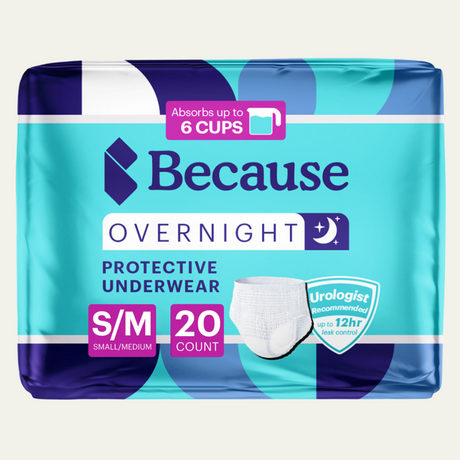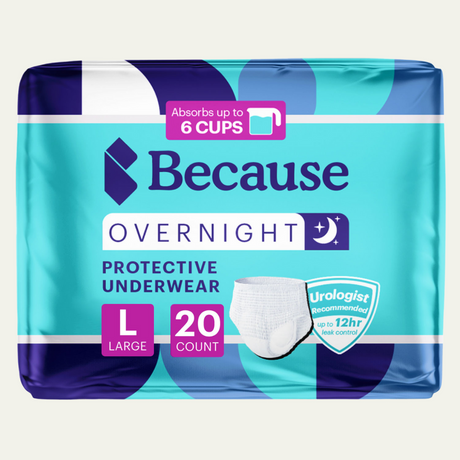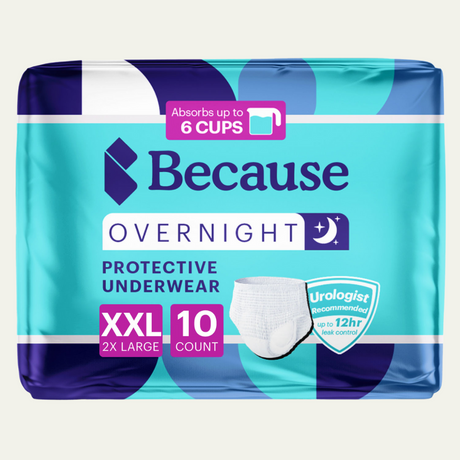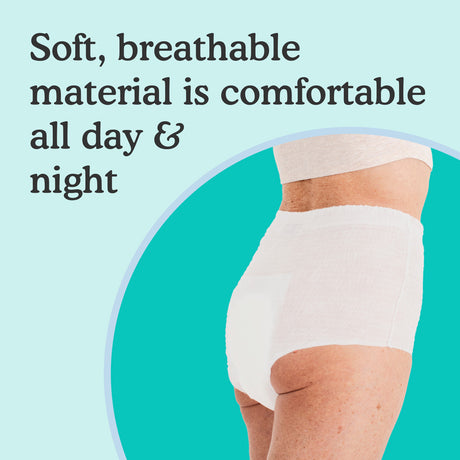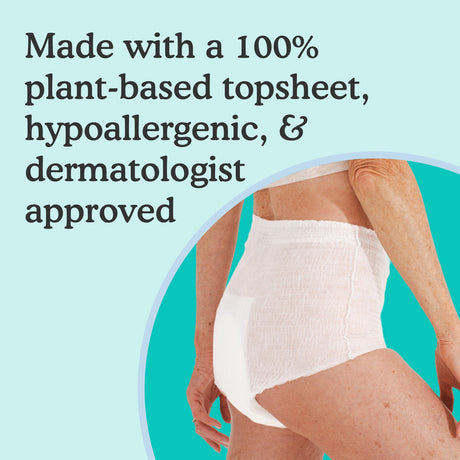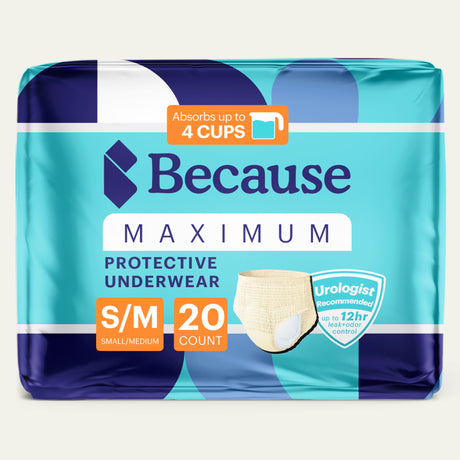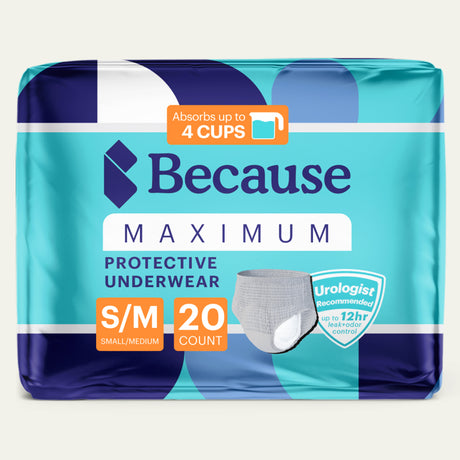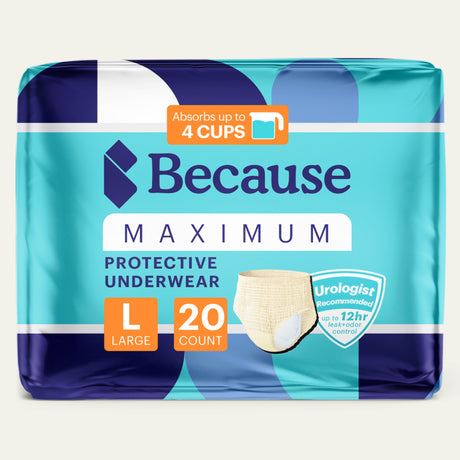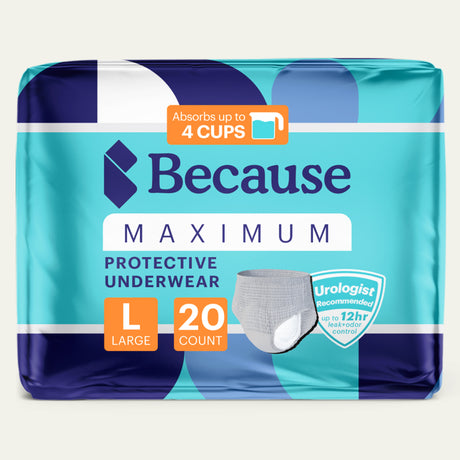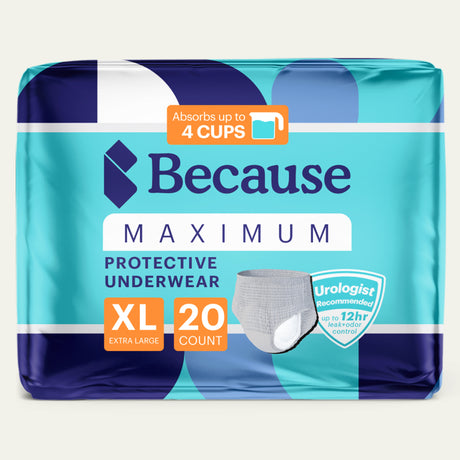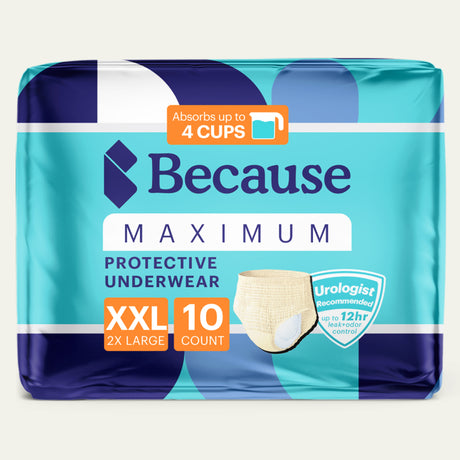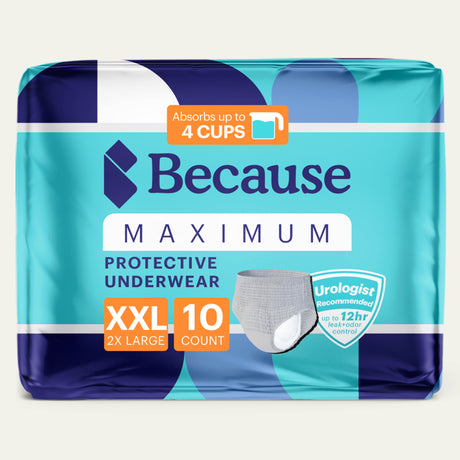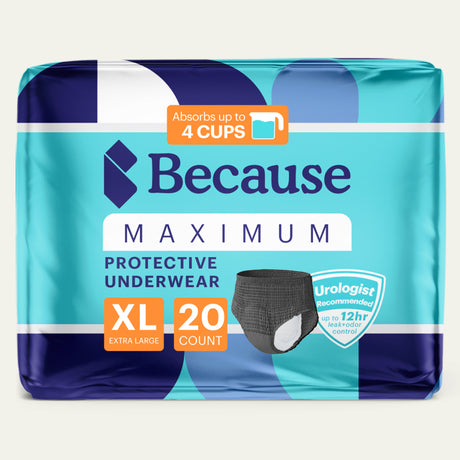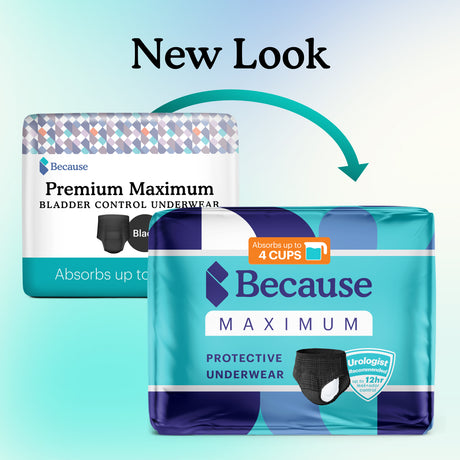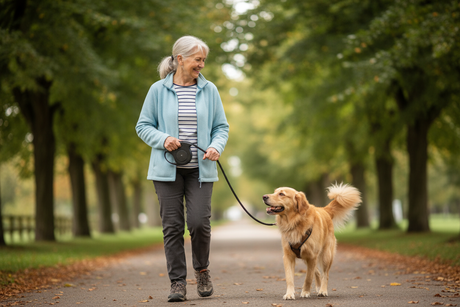Medically reviewed by Dr. Temitope Rude, MD
Urinary incontinence, the loss of bladder control, is a condition that many associate with aging. In fact, 53% of those in nursing homes experience incontinence. However, while it is more common among older adults, it is not an inevitable part of the aging process. Experiencing new bladder leaks as you age can be embarrassing and distressing, leading to a sense of isolation and self-consciousness. However, it's important to remember that you are not alone, and there are ways to manage and treat these symptoms. Understanding the causes, risk factors, and treatment options for urinary incontinence is crucial in managing this condition effectively.
Types of Urinary Incontinence
Understanding the different types of urinary incontinence is essential for identifying the most appropriate treatment and management strategies. Below are the primary types of incontinence, each with distinct characteristics and symptoms.
1. Stress Incontinence
Stress incontinence occurs when physical activity or exertion, such as coughing, sneezing, laughing, or lifting heavy objects, puts pressure on the bladder, leading to unintentional urine leakage. This type of incontinence is often associated with weakened pelvic floor muscles or connective tissue, which can result from childbirth, aging, or surgery.
Symptoms:
- Urine leakage during activities that increase abdominal pressure (e.g., exercise, coughing).
- Small to moderate amounts of urine leakage, depending on the severity.
2. Urge Incontinence
Urge incontinence is characterized by a sudden, intense urge to urinate, followed by involuntary urine loss. The most common cause of urge incontinence is overactive bladder (OAB). OAB can cause the bladder muscles contract too frequently or without warning, often leading to frequent trips to the bathroom. However, OAB can also occur without bladder spasms.
Symptoms:
- A strong, immediate need to urinate, often with little warning.
- Frequent urination, including waking up multiple times at night (nocturia).
- Large amounts of urine leakage, often before reaching the toilet.
3. Overflow Incontinence
Overflow incontinence happens when the bladder cannot empty completely, leading to frequent or constant dribbling of urine. This can occur due to a blocked urethra, weak bladder muscles, or nerve damage, causing the bladder to overfill and leak unexpectedly.
Symptoms:
- Continuous or intermittent dribbling of urine.
- Difficulty starting urination or feeling the need to strain.
- A sensation of incomplete bladder emptying.
4. Functional Incontinence
Functional incontinence is related to physical or cognitive impairments that prevent a person from reaching the toilet in time. Conditions such as arthritis, mobility issues, or dementia may make it challenging to use the bathroom when the need arises, leading to involuntary urine loss.
Symptoms:
- Urine leakage due to physical or mental barriers to reaching the toilet.
- The incontinence may vary depending on the severity of the underlying condition.
5. Mixed Incontinence
Mixed incontinence is a combination of more than one type of incontinence, most commonly stress and urge incontinence. Individuals with mixed incontinence experience symptoms of both types, such as leakage during physical activity and sudden urges to urinate.
Symptoms:
- A combination of symptoms from stress and urge incontinence.
- Varying amounts of urine leakage depending on the specific triggers.
6. Reflex Incontinence
Reflex incontinence occurs when the bladder empties automatically without the sensation of needing to urinate. This type is often associated with neurological conditions or spinal cord injuries that affect the nerves controlling the bladder.
Symptoms:
- Involuntary loss of urine without warning or the sensation of needing to urinate.
- Urine leakage at regular intervals, regardless of fluid intake.
By understanding these different types of urinary incontinence, individuals can better identify their symptoms and seek appropriate medical advice and treatment.

How to Prevent Incontinence as You Age
While aging can increase the risk of developing urinary incontinence, there are several proactive steps you can take to prevent or delay its onset. Implementing healthy lifestyle habits and practicing pelvic floor exercises can make a significant difference in maintaining a healthy bladder as you grow older. Below are some key strategies to help prevent incontinence as you age.
1. Strengthen Pelvic Floor Muscles
The pelvic floor muscles play a crucial role in supporting the bladder and controlling urine flow. Strengthening these muscles through regular Kegel exercises can help prevent stress incontinence and improve overall bladder control.
2. Maintain a Healthy Weight
Excess body weight places additional pressure on the bladder and pelvic floor muscles, increasing the risk of stress incontinence. Maintaining a healthy weight through a balanced diet and regular physical activity can help reduce this pressure and prevent incontinence.
Tips for Weight Management:
- Incorporate a variety of fruits, vegetables, whole grains, and lean proteins into your diet.
- Engage in regular aerobic exercise, such as walking, swimming, or cycling, for at least 150 minutes per week.
- Monitor your weight and make gradual, sustainable changes to your diet and exercise routine to achieve and maintain a healthy weight.
3. Stay Hydrated, but Avoid Bladder Irritants
Proper hydration is essential for bladder health, but certain beverages and foods can irritate the bladder and increase the likelihood of incontinence. It’s important to balance fluid intake and avoid common bladder irritants.
Bladder-Friendly Hydration Tips:
- Drink enough water throughout the day to stay hydrated, but avoid drinking large amounts at once, especially before bedtime.
- Limit or avoid caffeine, alcohol, carbonated drinks, and acidic foods, which can irritate the bladder.
- If you notice certain foods or beverages exacerbate your symptoms, try eliminating them from your diet to see if your symptoms improve.
4. Practice Bladder Training
Bladder training involves gradually increasing the time between bathroom visits to improve bladder capacity and control. This technique can be particularly helpful for individuals with urge incontinence or an overactive bladder.
5. Avoid Heavy Lifting and Straining
Frequent heavy lifting or straining, such as during bowel movements, can weaken the pelvic floor muscles and contribute to incontinence. To prevent this, it’s important to use proper lifting techniques and maintain regular bowel habits.
6. Address Chronic Health Conditions
Certain chronic health conditions, such as diabetes, arthritis, and neurological disorders, can increase the risk of developing incontinence. Managing these conditions effectively through regular medical care, medication adherence, and lifestyle adjustments can help reduce the likelihood of incontinence.
By incorporating these preventative measures into your daily routine, you can significantly reduce the risk of urinary incontinence as you age and maintain better bladder health.
Risk Factors for Urinary Incontinence
Urinary incontinence can be influenced by a variety of risk factors, making some individuals more susceptible than others. Here are the key risk factors:
- Age: Increased likelihood as muscles weaken with age.
- Gender: Women are more prone due to pregnancy, childbirth, and menopause.
- Obesity: Excess weight adds pressure on the bladder.
- Smoking: Chronic coughing from smoking can weaken pelvic muscles.
- Chronic Conditions: Diabetes, neurological disorders, and arthritis.
- Family History: Genetic predisposition to incontinence.
- Childbirth: Vaginal delivery can damage bladder control muscles.
- Hysterectomy: Surgery that affects pelvic floor support.
- Medications: Certain drugs can increase the risk of incontinence.
- Dietary Factors: Caffeine, alcohol, and acidic foods can irritate the bladder.

When to See a Doctor
If you experience urinary incontinence that affects your daily life, causes significant discomfort, or persists despite lifestyle changes and home remedies, it is important to consult a healthcare professional. Seek medical advice if you notice sudden or severe changes in your bladder control, if you experience pain or discomfort during urination, or if you have difficulty managing your symptoms with over-the-counter products.

Managing Incontinence or Bladder Leakage
Effectively managing urinary incontinence involves a multifaceted approach that combines lifestyle adjustments, medical treatments, and supportive products. Using bladder protection products, such as absorbent underwear, incontinence pads, and bed pads, can significantly enhance comfort and prevent leaks from disrupting daily activities and sleep.
Absorbent underwear or diapers offer discreet protection and come in various sizes and absorbency levels to suit individual needs. Incontinence pads, available in different sizes and absorbency options, can be worn with regular underwear for additional security.
Bed pads, which are available in both disposable and washable varieties, protect bedding and mattresses from nighttime leaks, ensuring a more restful sleep and easier clean up for caregivers.
Not sure which product is right for you? Take our bladder protection quiz and get a sample pack to try for just $2.99!

Bladder supplements can also play a role in managing incontinence symptoms. Supplements such as cranberry extract and D-Mannose are known for their potential to prevent urinary tract infections (UTIs), which can exacerbate incontinence. Probiotics can help maintain a healthy balance of bacteria in the urinary tract, potentially reducing the risk of infections.
Skin care is another important aspect of incontinence management. Using barrier creams can protect the skin from moisture and prevent irritation or breakdown. Gentle, alcohol-free cleansing wipes are convenient for maintaining hygiene and preventing skin discomfort. Moisture-absorbing powders can help keep the skin dry and reduce friction, which helps prevent chafing.
By integrating these products and strategies into your routine, you can manage urinary incontinence more effectively, maintain comfort, and improve your overall quality of life. It’s always advisable to consult with a healthcare provider before starting any new supplement or skincare product to ensure it aligns with your specific health needs.
Do you struggle with incontinence? Join one of our private support groups today:
FAQs
How do you stop urinary leakage in old age?
Stopping urinary leakage in old age involves a combination of strategies aimed at addressing the underlying causes and improving bladder control. Some strategies include: pelvic floor exercises, bladder training, lifestyle changes, medications, and medical interventions.
What is the average age of urinary incontinence?
The average age of onset for urinary incontinence varies depending on the type and underlying factors, but it generally becomes more prevalent as people age.
Can you reverse incontinence?
The ability to reverse urinary incontinence depends on its type, underlying causes, and individual health conditions. In many cases, incontinence can be managed effectively and, in some instances, significantly improved or even reversed.
Is incontinence for life?
Urinary incontinence is not necessarily a lifelong condition, though its duration and severity can vary depending on individual circumstances, including the type of incontinence, its underlying causes, and the effectiveness of treatment.
What type of incontinence is common in the elderly?
In the elderly, the most common types of urinary incontinence are urge incontinence and mixed incontinence.

Dr. Temitope O. Rude is a Clinical Assistant Professor at Stanford Urology. Dr. Rude received her B.A. in Neurobiology at Harvard University, and her MD from Stanford University. She completed her urology residency at New York University, followed by a fellowship in Female Pelvic Medicine and Reconstructive Surgery (FPMRS) at USC in 2020. Her research focuses on improving patient-reported outcomes post-surgery for pelvic organ prolapse, alongside groundbreaking work in the medical and surgical management of neurogenic bladder and complex voiding dysfunction.
Sources:
The Cleveland Clinic. (2024, Sept. 11). Urge Incontinence. https://my.clevelandclinic.org/health/diseases/22161-urge-incontinence
National Institute on Aging. (2022, Jan. 24). Urinary Incontinence in Older Adults. https://www.nia.nih.gov/health/bladder-health-and-incontinence/urinary-incontinence-older-adults
Vogel S. L. (2001). Urinary incontinence in the elderly. Ochsner journal, 3(4), 214–218.


